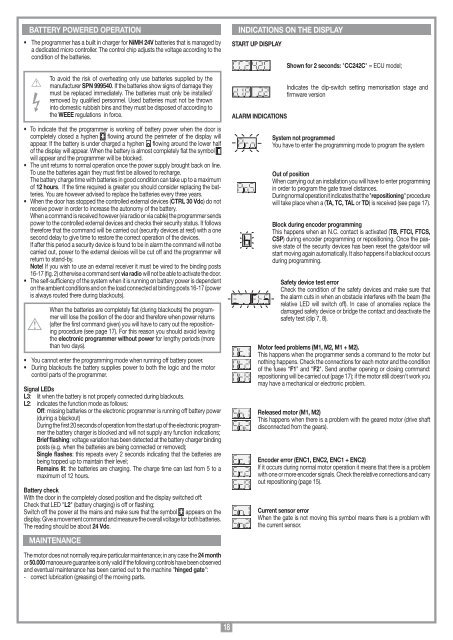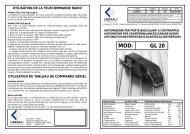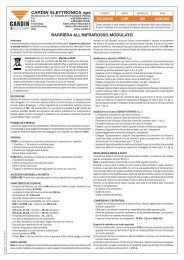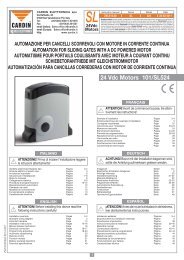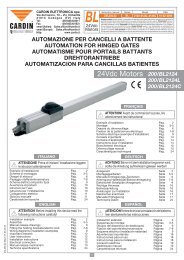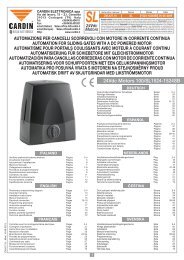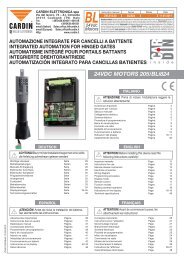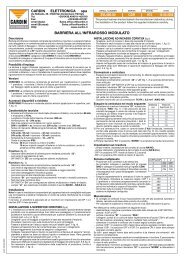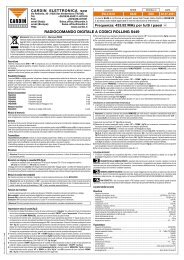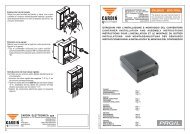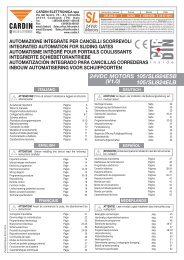24VDC MOTORS 205/BLi924 - Cardin Elettronica
24VDC MOTORS 205/BLi924 - Cardin Elettronica
24VDC MOTORS 205/BLi924 - Cardin Elettronica
- No tags were found...
You also want an ePaper? Increase the reach of your titles
YUMPU automatically turns print PDFs into web optimized ePapers that Google loves.
BATTERY POWERED OPERATION• The programmer has a built in charger for NiMH 24V batteries that is managed bya dedicated micro controller. The control chip adjusts the voltage according to thecondition of the batteries.To avoid the risk of overheating only use batteries supplied by themanufacturer SPN 999540. If the batteries show signs of damage theymust be replaced immediately. The batteries must only be installed/removed by qualified personnel. Used batteries must not be throwninto domestic rubbish bins and they must be disposed of according tothe WEEE regulations in force.• To indicate that the programmer is working off battery power when the door iscompletely closed a hyphen flowing around the perimeter of the display willappear. If the battery is under charged a hyphen flowing around the lower halfof the display will appear. When the battery is almost completely flat the symbolwill appear and the programmer will be blocked.• The unit returns to normal operation once the power supply brought back on line.To use the batteries again they must first be allowed to recharge.The battery charge time with batteries in good condition can take up to a maximumof 12 hours. If the time required is greater you should consider replacing the batteries.You are however advised to replace the batteries every three years.• When the door has stopped the controlled external devices (CTRL 30 Vdc) do notreceive power in order to increase the autonomy of the battery.When a command is received however (via radio or via cable) the programmer sendspower to the controlled external devices and checks their security status. It followstherefore that the command will be carried out (security devices at rest) with a onesecond delay to give time to restore the correct operation of the devices.If after this period a security device is found to be in alarm the command will not becarried out, power to the external devices will be cut off and the programmer willreturn to stand-by.Note! If you wish to use an external receiver it must be wired to the binding posts16-17 (fig. 2) otherwise a command sent via radio will not be able to activate the door.• The self-sufficiency of the system when it is running on battery power is dependenton the ambient conditions and on the load connected at binding posts 16-17 (poweris always routed there during blackouts).When the batteries are completely flat (during blackouts) the programmerwill lose the position of the door and therefore when power returns(after the first command given) you will have to carry out the repositioningprocedure (see page 17). For this reason you should avoid leavingthe electronic programmer without power for lengthy periods (morethan two days).• You cannot enter the programming mode when running off battery power.• During blackouts the battery supplies power to both the logic and the motorcontrol parts of the programmer.Signal LEDsL3: lit when the battery is not properly connected during blackouts.L2: indicates the function mode as follows:Off: missing batteries or the electronic programmer is running off battery power(during a blackout)During the first 20 seconds of operation from the start up of the electronic programmerthe battery charger is blocked and will not supply any function indications;Brief flashing: voltage variation has been detected at the battery charger bindingposts (e.g. when the batteries are being connected or removed);Single flashes: this repeats every 2 seconds indicating that the batteries arebeing topped up to maintain their level;Remains lit: the batteries are charging. The charge time can last from 5 to amaximum of 12 hours.Battery checkWith the door in the completely closed position and the display switched off:Check that LED "L2" (battery charging) is off or flashing;Switch off the power at the mains and make sure that the symbol appears on thedisplay. Give a movement command and measure the overall voltage for both batteries.The reading should be about 24 Vdc.MAINTENANCEINDICATIONS ON THE DISPLAYSTART UP DISPLAYALARM INDICATIONSShown for 2 seconds: "CC242C" = ECU model;Indicates the dip-switch setting memorisation stage andfirmware versionSystem not programmedYou have to enter the programming mode to program the systemOut of positionWhen carrying out an installation you will have to enter programmingin order to program the gate travel distances.During normal operation it indicates that the "repositioning" procedurewill take place when a (TA, TC, TAL or TD) is received (see page 17).Block during encoder programmingThis happens when an N.C. contact is activated (TB, FTCI, FTCS,CSP) during encoder programming or repositioning. Once the passivestate of the security devices has been reset the gate/door willstart moving again automatically. It also happens if a blackout occursduring programming.Safety device test errorCheck the condition of the safety devices and make sure thatthe alarm cuts in when an obstacle interferes with the beam (therelative LED will switch off). In case of anomalies replace thedamaged safety device or bridge the contact and deactivate thesafety test (dip 7, 8).Motor feed problems (M1, M2, M1 + M2).This happens when the programmer sends a command to the motor butnothing happens. Check the connections for each motor and the conditionof the fuses “F1" and “F2". Send another opening or closing command:repositioning will be carried out (page 17); if the motor still doesn’t work youmay have a mechanical or electronic problem.Released motor (M1, M2)This happens when there is a problem with the geared motor (drive shaftdisconnected from the gears).Encoder error (ENC1, ENC2, ENC1 + ENC2)If it occurs during normal motor operation it means that there is a problemwith one or more encoder signals. Check the relative connections and carryout repositioning (page 15).Current sensor errorWhen the gate is not moving this symbol means there is a problem withthe current sensor.The motor does not normally require particular maintenance; in any case the 24 monthor 50.000 manoeuvre guarantee is only valid if the following controls have been observedand eventual maintenance has been carried out to the machine "hinged gate":- correct lubrication (greasing) of the moving parts.18


